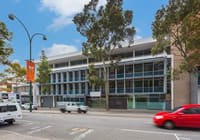
Office trend leads to 30pc cut in working space in Melbourne's T&G building
The landlord renovating the historic office considered Melbourne’s most beautiful building has released a series of layout options adopting the emergent activity based workplace (ABW) method, including some which would see workers occupy an average of 9.8 square metres – a third the standard of 20 years ago.
US-based Pembroke Real Estate is now marketing more than 20,000 square metres of space within the T&G Building, at 161 Collins Street, which it purchased for $275 million in late 2015, and has been renovating since long-time tenant KPMG recently moved to Docklands.
Not to be confused with hot-desking, where the employer provides employees a non-allocated workstation on an as-needs basis, ABW is a more flexible variation of the open-plan concept.
Still defined by non-assigned seating, ABW offers staff a variety of workplaces and rooms, including ones where, for example, meetings can be booked, phone calls can be quietly made, or colleagues can socialise, be it around a lounge or recreation space.
Private workplaces closed off from everyone can also be booked for hours, weeks or months.
The ABW concept provides the same cost advantages to landlords as hot-desking – some 20 per cent lower than the average rate, according to 2013 research by agency CBRE.
But cost is not necessarily the driving force behind the workplace occupancy trend. Research conducted since the buzz term started appearing five years ago also points to environmental and productivity advantages.
The ABW method has been adopted in recent times by technology companies including Google, Microsoft, National Australia Bank and KPMG, who use it amongst other things, to satisfy and retain staff.
Pembroke vice president, Head of Australia, Matthew Knight – a former development director at Charter Hall – thinks the large, rectangle layout of 161 Collins Street, offering natural light from three sides, lends itself to the open-plan-style fit out tenants are increasingly demanding.
Built between 1928 and 1931, then twice extended, the elegant T&G Building is renowned within office circles for its enormous floorplates, in some cases spreading 4200 square metres, or more than an acre.
Mr Knight said there are very few offerings in Melbourne where a company of more than 420 staff operate across one level of space, let alone a super-prized pocket of Collins Street.
Pembroke’s fit out includes an option for tenants to create an alfresco area on each floor – outdoor space a rarity in city tenancies. It will include walls tenants can shift as their requirements change. Building occupants are also expected to have use of a wellness centre.
On the ground level, Pembroke is moving the entrance of the 350-bay car park to Russell Street, so as to create a new laneway expected to be occupied by eateries and bars, and which will provide more direct access to Hosier Lane, Federation Square and the Flinders Street train station.
Tenant advocate Chris Goodwin, director of Goodwin Property Advisory, which has been placing companies of all sizes into Melbourne offices for more than 20 years, said the ABW concept is not simply bosses packing more employees into the same sized space.
“There are many ways the ABW concept helps make the running of a workplace more efficient,” Mr Goodwin said, citing that the method encourages efficient practices such as a paperless office.
“The compactus is becoming the dinosaur of the past,” Mr Goodin said.
He said one of the more common occupant complaints about the open-plan concept – distraction from noise – can be dealt with via implementing clear communication strategies and utilising technology including programs allowing instant messages for the person sitting next to you.
The broker said that in the 1990s, the Melbourne CBD worker occupied an average of about 28 square metres. With the open-plan concept becoming popular after that, the rate averages between 10 and 12 square metres now.
ABW is not for all companies, however. The method is better suited to companies which employ project-based, rather than autonomous workers.
Pembroke is factoring this variation into its extensive refurbishment of 161 Collins Street, with larger proposed layouts allocating for 14 square metres per person, and which the tenant has the potential to increase.
Colliers International’s Andrew Beasley and Edward Knowles are leasing the building’s available space for Pembroke. Recently, sitting tenant IOOF doubled its occupancy to 8000 square metres.
The prestigious 12-level, 43,000 square metre building was judged in a 1930 survey by The Herald as Melbourne’s most beautiful building – a title it still holds for many, more than 85 years later.
In 2015 Pembroke secured global IT giant Apple to the former ANZ Bank office at 20 Martin Place, Sydney, which it acquired for $95 million in 2011.












